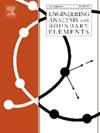Gradient-constrained algorithm for simulating bubble growth in microchannel boiling flow using volume of fluid method
IF 4.2
2区 工程技术
Q1 ENGINEERING, MULTIDISCIPLINARY
Engineering Analysis with Boundary Elements
Pub Date : 2025-01-01
DOI:10.1016/j.enganabound.2024.106051
引用次数: 0
Abstract
This study focuses on the numerical simulation of bubble growth in microchannels and addresses the interfacial deformations associated with phase transitions in the Volume of Fluid (VOF) method. In order to avoid the blurred deformation of the interface during bubble growth, a gradient-constrained algorithm is proposed to simulate bubble growth with sharp interface. The algorithm proposed in this paper is to compress the phase interface by selecting a suitable gradient range of the gas phase volume share change, and then adjust the position of the gas phase mass source to the compressed interface. It is recommended that the selected minimum value of the gas phase volume fraction gradient mode value falls between 20 % and 50 % of the maximum value. The proposed method is verified by three engineering problems: bubble growth in the microchannel, Taylor bubble movement in the microchannel and bubbles side-by-side rise and coalescing. The simulation results of these three engineering problems show good agreement with other researchers' simulation, theoretical model and experimental results. The algorithm proposed in this paper is more convenient in capturing the phase interface and describing the evaporation process.
用流体体积法模拟微通道沸腾流中气泡生长的梯度约束算法
本文研究了微通道中气泡生长的数值模拟,并解决了流体体积(VOF)方法中与相变相关的界面变形。为了避免气泡生长过程中界面的模糊变形,提出了一种梯度约束算法来模拟具有尖锐界面的气泡生长。本文提出的算法是通过选择合适的气相体积份额变化梯度范围来压缩相界面,然后将气相质量源的位置调整到压缩界面。建议选择气相体积分数梯度模式值的最小值在最大值的20% ~ 50%之间。通过微通道内气泡生长、微通道内泰勒气泡运动以及气泡并排上升和聚并三个工程问题验证了该方法的有效性。这三个工程问题的仿真结果与其他研究人员的仿真、理论模型和实验结果吻合良好。本文提出的算法更便于捕获相界面和描述蒸发过程。
本文章由计算机程序翻译,如有差异,请以英文原文为准。
求助全文
约1分钟内获得全文
求助全文
来源期刊

Engineering Analysis with Boundary Elements
工程技术-工程:综合
CiteScore
5.50
自引率
18.20%
发文量
368
审稿时长
56 days
期刊介绍:
This journal is specifically dedicated to the dissemination of the latest developments of new engineering analysis techniques using boundary elements and other mesh reduction methods.
Boundary element (BEM) and mesh reduction methods (MRM) are very active areas of research with the techniques being applied to solve increasingly complex problems. The journal stresses the importance of these applications as well as their computational aspects, reliability and robustness.
The main criteria for publication will be the originality of the work being reported, its potential usefulness and applications of the methods to new fields.
In addition to regular issues, the journal publishes a series of special issues dealing with specific areas of current research.
The journal has, for many years, provided a channel of communication between academics and industrial researchers working in mesh reduction methods
Fields Covered:
• Boundary Element Methods (BEM)
• Mesh Reduction Methods (MRM)
• Meshless Methods
• Integral Equations
• Applications of BEM/MRM in Engineering
• Numerical Methods related to BEM/MRM
• Computational Techniques
• Combination of Different Methods
• Advanced Formulations.
 求助内容:
求助内容: 应助结果提醒方式:
应助结果提醒方式:


